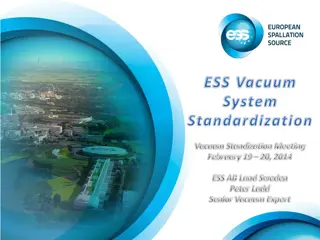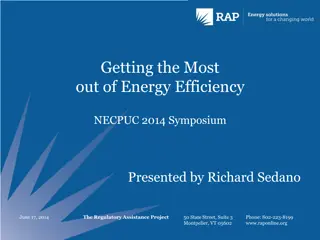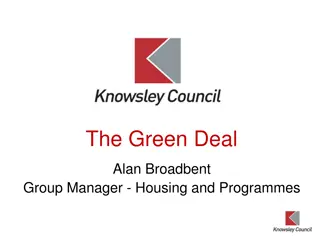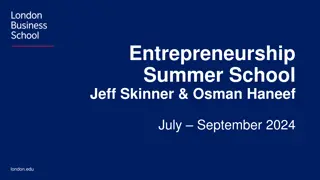Overview of ESS Sustainability Program and Energy Efficiency Initiatives
The ESS Sustainability Program addresses various environmental issues and highlights key values such as community, service, openness, sustainability, and credibility. The program focuses on energy efficiency, renewable contracts, and electricity consumption. Additionally, the analysis of the electricity market in Sweden and the importance of efficiency for resource allocation and stakeholder satisfaction are discussed.
Download Presentation

Please find below an Image/Link to download the presentation.
The content on the website is provided AS IS for your information and personal use only. It may not be sold, licensed, or shared on other websites without obtaining consent from the author.If you encounter any issues during the download, it is possible that the publisher has removed the file from their server.
You are allowed to download the files provided on this website for personal or commercial use, subject to the condition that they are used lawfully. All files are the property of their respective owners.
The content on the website is provided AS IS for your information and personal use only. It may not be sold, licensed, or shared on other websites without obtaining consent from the author.
E N D
Presentation Transcript
ESS Sustainability Program Some issues ESHAC #5 Peter Jacobsson Head of Environment, Safety & Health
ESS core values The core values of ESS are: Community and collaboration Service Openness Sustainability Credibility 2
On-going work Renewable Contract for electricity in place for the construction of ESS up until 2018-12-31. Procurement will start for a contract 2019-2023 Energy efficiency (reduction of electricity consumption) The accelerator The target The buildings Recovery of energy Recuperated heat solutions is under way Has to be a solution that is beneficial for both ESS and its counterpart 4
Electricity market in Sweden A common market for the Nordic and Baltic countries; NordPool Possible for customers to choose a supplier (although the owner of the local grid has a monopoly) Production in Sweden 2015; 158,5 TWh Hydropower; 74 TWh (47 %) Nuclear Power; 54,4 TWh (34 %) Wind Power; 16,6 TWh (10 %) Other; 13,5 TWh ( 9 %) A very low electricity market price for 2015 A good opportunity for purchasing electricity 5
Why try to be as efficient as possible? More resources for research Environmental friendly The differences on the electricity market price will have less effect on the operation budget The stakeholders are satisfied A good margin in the design gives a possibility of future investments in a sustainable facility 6
Electricity consumption of ESS current estimate Estimated annual electricity consumption [GWh] Part of facility Accelerator Target Cryo CF** Neutron Scattering Systems Integrated Control Systems CUB Total [GWh] 2012* 189 34 2013* 191,5 34,6 2013 119 21,1 44,4 7,2 2014 109,6 3,2 42,5 4,9 2014 110,3 3,8 41,1 5,3 4 8,9 14 10,5 10,5 29,5 29,5 3,2 4,1 4,1 49 290 71 317 60 265 96 290 34,4 229 * Cryo was included in Accelerator ** Cooling/HVAC not included
Reusing the excess heat Originally, the intention was to send back/sell/give the excess heat to the district heating system of Lund. However, the district heating company demanded that they would only accept an inlet temperature of 90 C while the outlet temperature from the water cooled accelerator components would be 50 C. What to do Use the energy for heating up the ESS buildings Use the energy for a new local district heating system Find a partner who can take care of the 50 C water 8
Summary Best estimate of the electricity consumption is 229 GWh. Uncertainties still exist for the calculated electricity consumption still exist. Some overlap between accelerator/target/CF exist. A new solution for the recuperated heat solutions heat are under way that will lower the electricity consumption Many open possibilities for improvements regardless of chosen cooling solution 11
BREEAM BREEAM = Building Research Establishment Environmental Assessment BREEAM is an environmental performance certification system that can be applied at building and/or community level Management Health & Wellbeing Energy Transport Water Material Waste Land use & Ecology Pollution 12
Green field project High grade arable land (class 10) Ambition to restore the land to the quality that is regulated in the detailed plan currently applicable during decommissioning. Technically it is possible to restore the land to be arable or for residential development. Impact on open agricultural landscape Facility is designed so that its impact on the open agricultural landscape is not greater than necessary and so that it, despite its size, may be perceived as a positive addition to the skyline. Natural values in cultivated arable land are generally low The property is going to be designed to promote biodiversity. 13
Sustainable material selection Phase out of hazardous substances by using BVB, SundaHus, BASTA Avoiding materials containing halogens (F, Cl, Br) sulfur hexafluoride (SF6) high VOC-emissions zinc/copper in materials situated outdoors and in contact with water Life cycle perspective Responsible Sourcing Wood originates from sustainably managed forests 15
BREEAM buildings GUARD HOUSE LABORATORY OFFICES TARGET EXPERIMENTAL HALLS SHIPPING & RECEIVING WASTE BUILDING ACCELERATOR (not tunnel) 16
Construction site impact Handling of chemicals Noise Air pollution Water Groundwater Spill and leakage Excavated soil Dust Road sweeping Light emissions Waste Energy 17
Water management system Hoby Outgoing flow pH Suspended solids Oil Igel sa Pugg ngarna 19























